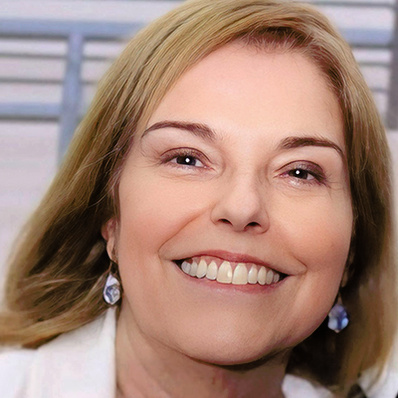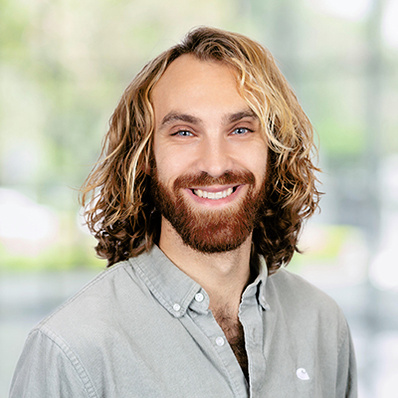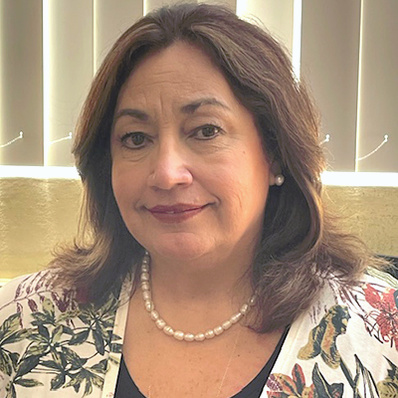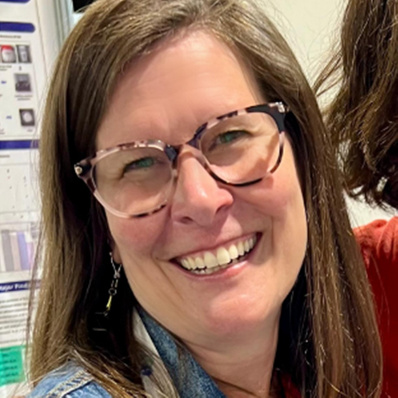- You are here:
- SETAC
- Discover Events
- Global Meetings
- SETAC Latin America 16th Biennial Meeting
- Program
- Plenary Speakers
Plenary Speakers

Helena Cristina da Silva de Assis
Federal University of Paraná

Helena Cristina da Silva de Assis
Federal University of Paraná
One Health Approach in Environmental Toxicology
The presentation addresses the concept of One Health, which integrates human, anima, and environmental health, recognizing their interdependence in the face of challenges such as environmental disasters, microplastic contamination, antimicrobial resistance and climate change. It highlights the role of environmental toxicology in risk assessment and health impact monitoring, particularly in the context of ecosystem and water resource degradation. The need to improve toxicological testing and data analysis within this integrated perspective is emphasized, along with the importance of public policies to ensure a more holistic, effective and responsible approach to managing toxicological risks.
Helena Cristina da Silva de Assis graduated with a degree in Veterinary Medicine from the Federal University of Paraná, where she also earned a master’s degree in Veterinary Sciences. She obtained her Ph.D. in Natural Sciences from the Technical University of Berlin, Germany, and later completed a postdoctoral fellowship in Environmental Genomics at the University of Ottawa, Canada. Helena is a retired Full Professor from the Department of Pharmacology at the Federal University of Paraná and currently serves as a senior professor in the postgraduate programs in Pharmacology and Ecology and Conservation. She holds a Productivity Scholarship (PQ1B / CNPq) and conducts research in the fields of ecotoxicology, biomarkers, biomonitoring, cyanotoxins and phytoremediation. Additionally, she is a reviewer for several national and international scientific journals and evaluates research projects for CAPES, CNPq and various state foundations. She is a co-founder of One Health-Nano and Eco Consultancy and has been a researcher at the Institute of Science and Technology of Aquatic Toxicology (INCT-TA). She served as President of the SETAC Latin America (2017–2018) and later became President of the SETAC World Council (2020–2021), making history as the first Latin American representative to hold this position. She is also a member of the SETAC Advisory Panel on Chemicals Management, supporting SETAC’s representation on the United Nations Environment Programme (UNEP) Open-Ended Working Group.

Milo de Baat
University of Amsterdam

Milo de Baat
University of Amsterdam
Holistic Water Quality Assessment in a Changing World
This presentation highlights recent methodological and conceptual advancements in water quality assessment. Aquatic ecosystems are at risk from an ever-growing diversity of chemicals, increasingly in combination with multiple other stressors. Technological improvements enable the elucidation of chemical mixture composition and toxicity at an unprecedented level of detail and speed. However, we are only just starting to fully grasp the links between mixture toxicity and aquatic ecosystem structure and functioning. This field of research is ripe for discovery and offers many opportunities for the implementation of novel technologies and the integration of the fields of environmental chemistry, toxicology and ecology. Examples will be discussed, demonstrating the integration of state-of-the-art methods to better understand the relationship between chemical water quality, toxicity, and biodiversity loss. Particular attention will be given to applicability in the Latin American context.
Milo de Baat is an Assistant Professor in Water Quality and Ecotoxicology at the University of Amsterdam. His research explores how chemical pollution affects the health of aquatic ecosystems. Water is essential to life, but human activities impose an increasingly complex chemical burden on freshwater and marine environments. This pollution negatively impacts biodiversity, disrupts ecosystem functioning, and threatens the availability of clean and safe water for human use and consumption. By combining innovative sampling methods with effect-based toxicity assessment, Milo's research aims to unravel the complexity and toxic effects of chemical mixtures in the environment. By aligning these findings with knowledge of biodiversity and ecosystem functioning, he strives to quantify the limitations that chemical pollution imposes on environmental health across various aquatic ecosystems.

María del Carmen Gastañaga Ruíz
National University of San Marcos (Lima)

María del Carmen Gastañaga Ruíz
National University of San Marcos (Lima)
Impact of Pollutants on the Environment and Health
It is evident that chemicals are a significant part of our way of life, and we must understand that all the chemicals we are exposed to pose a risk to our health. Many Latin American countries are no exception to this reality, as they can have a significant impact on public health, causing illnesses, as some of their effects are related to the hormonal, nervous and immune systems, or cancer, as well as their impact on the environment.
There are a variety of chemicals to which we are exposed, but we will mention two of them: heavy metals and pesticides. Regarding heavy metals, four have been prioritized in our country: mercury, arsenic, cadmium and lead, due to their effects on health, especially neurological ones, causing a variety of problems that impact the quality of life, especially among vulnerable populations of children, pregnant women and the elderly.
In the case of pesticides, these can have serious impacts on human health, both short- and long-term. Exposure to pesticides, whether through inhalation, ingestion, or skin contact, can cause a variety of health problems, including skin and eye irritation, respiratory problems, and, in more severe cases, neurological, reproductive, and carcinogenic effects. The groups most vulnerable to these effects are children, pregnant women, agricultural workers and the elderly. In the presentation, we will discuss the importance of understanding and analyzing the presence of these substances, the type of exposure and their sources. This will determine the appropriate course of action, medical evaluation, and subsequent management.
María del Carmen Gastañaga Ruíz is a Medical Surgeon who graduated from the San Fernando School of Medicine at the National University of San Marcos in Lima. She specializes in Physical Medicine and Rehabilitation as well as Environmental Management. In addition, she has completed studies in a Master’s in Pedagogical Innovation and Management of Educational Centers and a Master’s in Educational Policy and Management. She currently works as a Physician at INS CENSOPAS (National Institute of Health and Social Welfare). Previously, she served as the President of the Committee of Experts for the Care of People Exposed to Heavy Metals and Other Chemical Substances (RM No. 370-2020-MINSA). With over 20 years of experience in environmental and occupational health management, her expertise focuses on environmental and occupational epidemiology and toxicology related to both communicable diseases and those caused by chemical and physical environmental and occupational agents. She has actively participated in training and research on heavy metals and has authored publications on environmental and occupational health topics. Additionally, she is a university professor specializing in environmental and occupational issues at the graduate level.

Michelle Embry
Health and Environmental Sciences Institute (HESI)

Michelle Embry
Health and Environmental Sciences Institute (HESI)
Towards One Health: Toxicokinetics at the Intersection of Human and Ecological Health
This presentation will highlight the role toxicokinetics (TK) plays in realizing the vision of a One Health approach to chemical risk assessment, emphasizing the common needs and challenges across human, animal, and ecological health. Although human and ecological risk assessments are often addressed in separate silos, measurements or predictions for TK properties—such as biotransformation rates—are required inputs for all Physiologically-Based Pharmacokinetic (PBPK) models, whether for humans, rats, fish or birds. This information is also essential for performing in vitro to in vivo extrapolation (IVIVE), a critical step for applying new approach methodologies (NAMs) data to real-world organisms or populations. Addressing uncertainties in TK, particularly regarding biotransformation, will require fostering collaborations that enhance data collection and model development. Improved interspecies and inter-taxa comparisons will also be vital for extending research applicability across different biological systems.
Michelle Embry is the Deputy Director of the Health and Environmental Sciences Institute (HESI Global), a non-profit organization with a mission to develop science for a safer, more sustainable world. She is also the Director of HESI’s Center for Environmental and Ecological Health. She holds a Ph.D. in toxicology and a B.S. from Duke University and has over 20 years of expertise in human and health and ecological risk assessment, with a focus on methods and approaches to ensure safe and effective use of chemicals and products. Her work at HESI brings together scientists from multiple sectors, geographies and disciplines to address current challenges related to the safety of chemicals for humans and the environment. In 2020, Embry led the formation of the Botanical Safety Consortium, a public-private partnership coordinate by HESI that is aimed at developing strategies to evaluate the safety of botanical products used in dietary supplements and cosmetics. She also leads the HESI Global Risk Assessment Training Center (GRATC), an initiative aimed at increasing access to and availability of foundational chemical risk assessment training and resources, particularly in low and middle-income and resource-limited regions. Prior to joining HESI, Embry was a biologist at the USEPA’s Office of Pesticide Programs, Environmental Fate and Effects Division, where she performed pesticide ecological risk assessments. Her doctoral work at Duke University focused on mechanisms of chemical carcinogenesis in fish models, including primary and immortalized fish cell lines. Embry has over seventy publications in the peer reviewed literature and has served on numerous international advisory committees, including the Canadian Government Chemicals Management Plan Science Committee from 2017–2021. She served on the SETAC North America Board of Directors from 2014–2017 and was a Counselor for the Society of Toxicology’s Exposure Specialty Section from 2021–2024. She currently serves on the USEPA’s Board of Scientific Counselors Research Strategy and Implementation Subcommittee and is a co-editor of Elsevier’s newly-launched NAM Journal.
